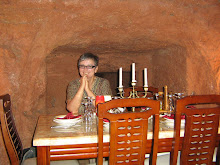
My electronic world is collapsing around me - last night I couldn't get a signal on the TV and this morning I couldn't get into my email server. But my blog still comes up so I must be real! This post is about my visit to the Hypogeum that is located in Paula. We weren't allowed to take photos underground, so the picture is of the well in the Christmas village at the Opera House.
Paula is one of the crowded towns on the edge of Grand Harbour but away from the sea. The central square was built in the 1900s and the housing to the south was developed around the turn of that century. It was during one of the housing developments that the vast underground system of Hal Saflieni Hypogeum was discovered although nothing was said about it for another three years, presumably to enable the construction of the houses that now cover the entire site and eradicated any of the ancient external structures.
The Hypogeum is an extensive system of underground burial chambers where it is estimated 7,000 people were buried. The caves were extended from natural hollows in the ground and as one part filled up, additional chambers were excavated. It seems that people were placed in a crouched position in smaller side chambers together with funerary objects such as pottery. At the time of the early work of exploration of the site first by Father Magri from 1901 who died before he was able to put together the information that was emerging and later by Temi Zammit from 1906, it was the pottery that yielded most data about the site. At that time, meticulous examination of the bones was not considered useful but it appears from the way in which the bones were jumbled together that the practice was to push piles of bones to one side as it became necessary to add someone else from the family group.
Some of the pottery was from the early Zebbug phase around 4,000BC. This was mostly located near the entrance showing how on this underground site, dating went in the opposite direction to surface sites as the people using the site carved out deeper caves as they were needed. Most of the pottery found was from the Ggantija, Saflieni and Tarxien phases up to 2,500BC but nothing after that period and it remains unclear what happened at that time to abruptly cause the end of the temple culture. The pottery that was found included several of the figurines depicting a large, sleeping lady that are now so familiar in tourist shops around Malta.
It has taken me several months to get myself sufficiently organised to book a place on a Hypogeum tour. When David Trump was here for the week of archaeology, he guided four tours of the Hypogeum, but I was too late to get on any of them. Since then there has been lots of other things happening. Now is the off-season for visitors to Malta so I knew it would be easier but each time I called in to the Museum of Archaeology in Valletta to book a place, there was some problem with computers and I kept putting it off. In the end, I remembered at the right time, in the right place and with the computers functioning albeit I was re-directed to the Heritage Malta office because the computer at the Museum couldn't handle my membership card. All this should have prepared me for a well-polished packaged experience when I got to the site office that is sandwiched between general housing in Paola. The group of 12 were each given an electronic guide in the appropriate language and we were accompanied by a young Greek guide who ushered us through the various chambers with appropriate reminders about when to duck our heads or look out for the step.
In spite of all that, I was stunned by the central temple chamber. This is a replica of what the temples above ground must have been like, even mimicking the form of construction of the domed ceilings with corbelled stone blocks, pillars with chequered carving and red ochre painting of spirals and honeycomb cells. The lighting and air conditioning in the site has been designed for conservation purposes, but it also enhances the mystery of the place as different corners, side chambers and curves are lit up or cast into shadow. And all this is happening as everyday life continues in the streets and houses of modern Paula above our heads!

1 comment:
I went to the Hypogyum last year and was really amazed by the place. I'm bringing my parents to Malta for Easter and this will be one of the place I will take them for sure.
(Really cool blog BTW, Jo :))
Post a Comment